读书笔记《hands-on-full-stack-development-with-spring-boot-2-0-and-react》Reaction有用的第三方组件
React 是基于组件的,我们可以在我们的应用程序中找到许多有用的第三方组件。在本章中,我们将看看我们将在前端使用的几个组件。我们将了解如何找到合适的组件以及如何在自己的应用程序中使用这些组件。
在本章中,我们将看到以下内容:
- How to find third-party React components
- How to install components
- How to use the React Table component
- How to use the modal window component
- How to use the Material UI component library
- How to manage routing in React
在本书中,我们使用的是 Windows 操作系统,但所有工具都可用于 Linux 和 macOS 作为 Node.js 并且 create-react-app 必须安装.
有很多不错的 React 组件可用于不同的目的。我们的首要任务是找到适合您需求的组件。 JS.coach (https://js.coach/)。您只需 输入关键字、搜索并从框架列表中选择 React。在以下屏幕截图中,您可以看到对 React 的表组件的搜索:
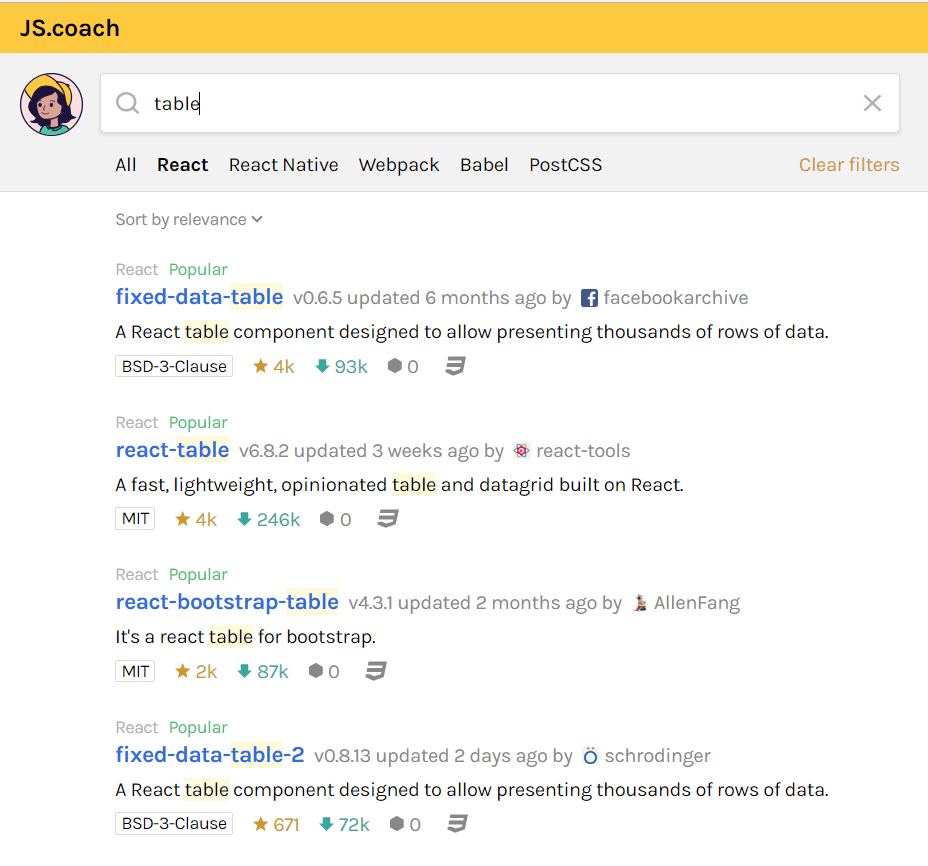
React 组件的另一个好来源是 Awesome React 组件(https://github.com/brillout/awesome-react-components)。
组件通常有很好的文档,可以帮助您在自己的 React 应用程序中使用它们。让我们看看如何将第三方组件安装到我们的应用程序并开始使用它。导航到 JS.coach 站点,键入 list 搜索输入字段,并按 React< /强>。从搜索结果中,您可以找到列表组件,名为 react-tiny-virtual-list:
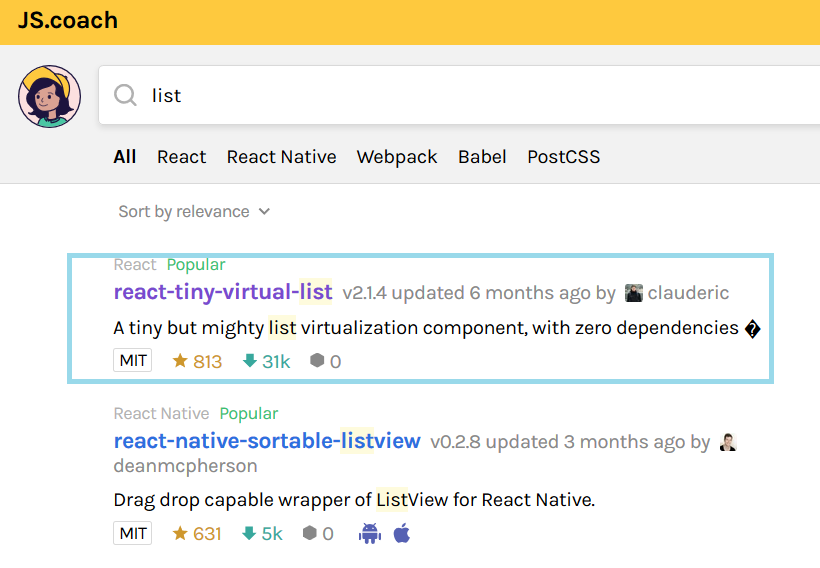
单击组件链接可查看有关组件的更多详细信息。很多时候,您可以在那里找到安装说明以及如何使用该组件的一些简单示例。信息页面通常会提供组件的网站或 GitHub 存储库的地址,您可以在其中找到完整的文档:
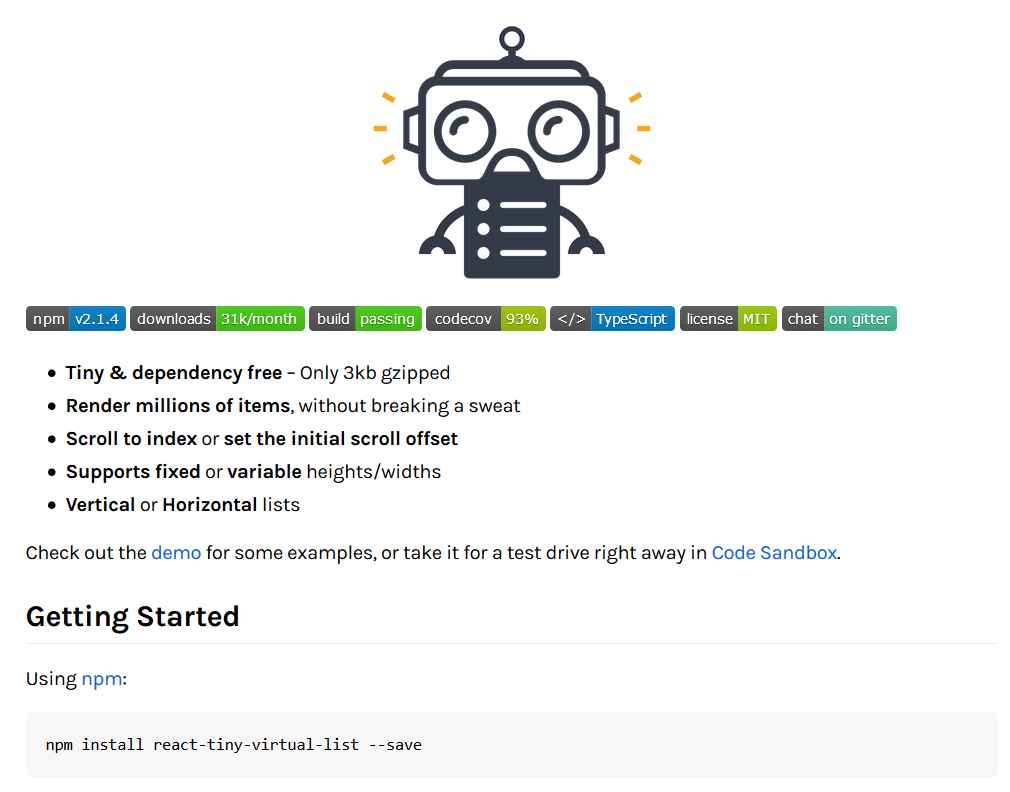
从组件的信息页面可以看到,组件的安装是使用 npm 完成的。该命令的语法如下:
或者,如果您使用的是 Yarn,则如下所示:
--save 参数将组件的依赖保存到 React 应用根文件夹中的 package.json 文件.如果您使用的是 npm 版本 5 或更高版本,则默认情况下会这样做,没有 --save 参数。使用 Yarn,您不必指定它,因为它默认保存组件依赖项。
现在我们将 react-tiny-virtual-list 组件安装到我们在上一章创建的 myapp React 应用程序中。您必须移动到您的应用程序根文件夹并键入以下命令:
如果您从应用根文件夹中打开 package.json 文件,您可以看到该组件现在已添加到依赖项中:
已安装的组件将保存到您应用的node_modules 文件夹中。如果您打开该文件夹,您应该会找到 react-tiny-virtual-list 文件夹:
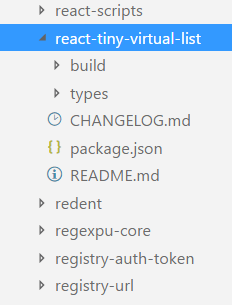
现在,如果您将 React 应用程序源代码推送到 GitHub,则不应包含 node_modules,因为该文件夹非常大。 create-react-app 包含.gitignore 文件,不包括 node_modules来自存储库的文件夹。 .gitignore 文件的内容如下所示:
这个想法是,当您从 GitHub 克隆您的应用程序时,您输入 npm install 命令,该命令从 包中读取依赖项.json 文件并将它们下载到您的应用程序。
开始使用已安装组件的最后一步是将其导入到您正在使用它的文件中:
React Table (https://react-table.js.org) 是一个灵活的table 组件用于 React 应用程序。它具有许多有用的功能,例如过滤、排序和旋转。让我们使用我们在 previous 一章中创建的 GitHub REST API 应用程序:
- Install the
react-tablecomponent. Open PowerShell and move to therestgithubfolder, which is the root folder of the app. Install the component by typing the following command:
- Open the
App.jsfile with the VS Code and remove all code inside therender()method except thereturnstatement with the divider containing the button and input field. Now theApp.jsfile should look like the following:
- Import the
react-tablecomponent and style sheet by adding the following lines at the beginning of theApp.jsfile:
- To fill React Table with data, you have to pass the data prop to the component. Data can be an array or object and therefore we can use our state, called
data. Columns are defined using the columns prop and that prop is required:
- We will define our columns by creating the array of column objects into the
render()method. In a column object, you have to define at least the header of the column and the data accessor. The data accessor values come from our REST API response data. You can see that our response data contains an object calledowner, and we can show these values using theowner.field_namesyntax:
- Add the React Table component to our
render()method, and then the source code of the method looks like the following:
- Run the app and navigate to
localhost:3000. The table looks quite nice. It has sorting and paging available by default:
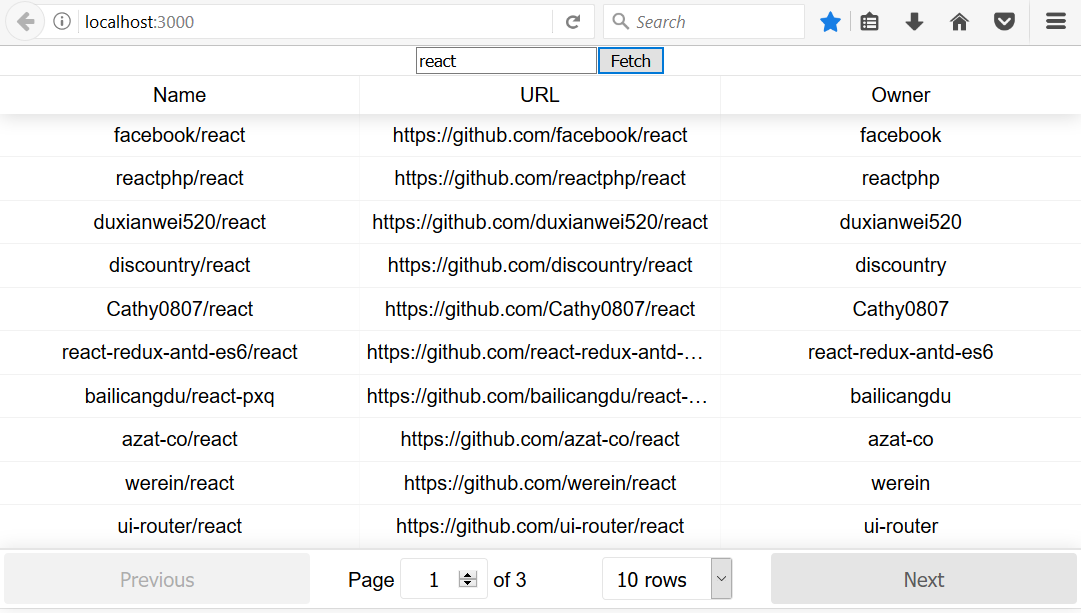
默认情况下禁用过滤,但您可以使用 filterable prop 在 ReactTable 组件中启用它。您还可以设置表格的页面大小:
现在您应该在表格中看到过滤器元素。您可以使用任何列进行过滤,但还有一个选项可以在列级别设置过滤和排序:

您可以从 React Table 网站找到表格和列的不同道具。
单元格渲染器可用于自定义表格单元格的内容。以下示例显示了如何将按钮呈现到表格单元格。单元格渲染器中的函数将 value 作为参数传递,在这种情况下,该值将是 full_name,这是定义的在列的访问器中。另一种选择是传递一行,它传递整个行反对函数。然后,您必须定义 btnClick 函数,该函数在按下按钮时被调用,您可以对发送到函数的值执行一些操作:
以下是带有按钮的表格的屏幕截图:
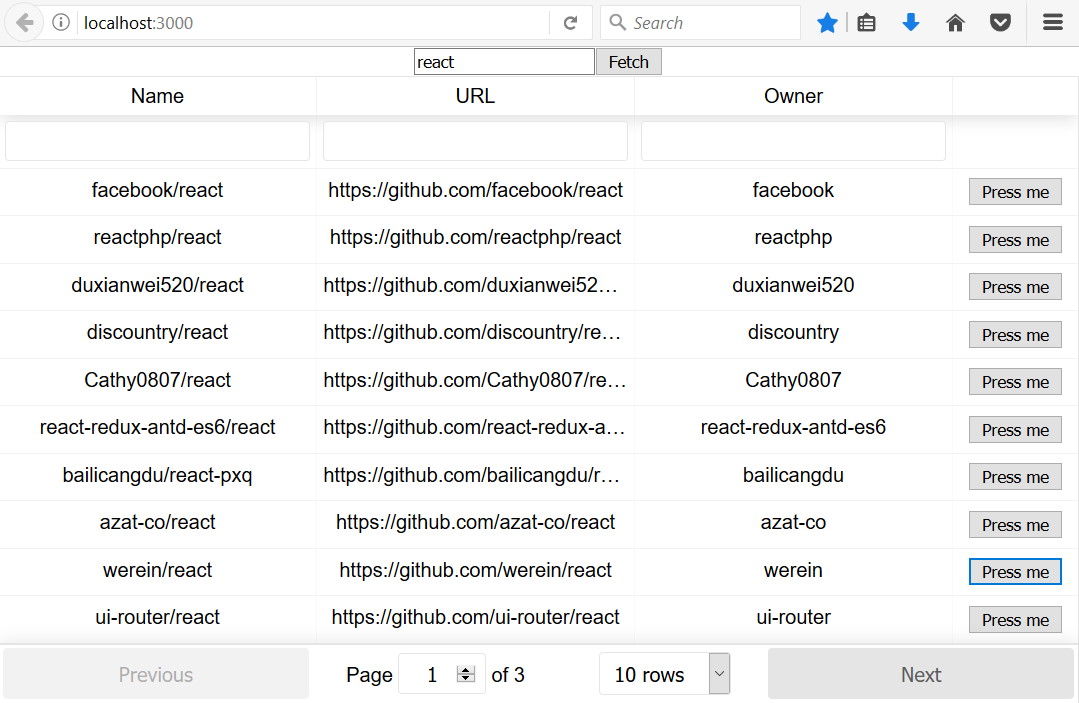
当 您正在创建CRUD 应用程序时,模态窗口非常适合。我们将创建一个简单的购物清单应用程序,用户可以在其中使用模式窗口添加新商品。我们将在示例中使用的模态窗口组件是 react-skylight (https://marcio.github.io/react-skylight/):
- Create a new React app called
shoppinglistand installreact-skylightby using the following command:
- Open the
appfolder with the VS Code and open theApp.jsfile in the code editor. In theApp.jscomponent, we need only one state to keep shopping list items. One shopping list item contains two fields—product and amount. We also need a method to add new items to the list. The following is the source code of the constructor and the method for adding new items to the list. In theaddItemmethod, we are using a spread notation (...), which is used to add a new item at the beginning of the existing array:
- Add a new component for adding shopping items. Create a new file called
AddItem.jsto the root folder of the app. This component will use the React Skylight modal form so let's importreact-skylight. Inside the React Skylight component in therender()method, we will add two input fields (productandamount) and a button that calls theaddItemfunction. To be able to call theaddItemfunction that is in theApp.jscomponent, we have to pass it in a prop when rendering theAddItemcomponent. Outside the React Skylight component, we will add a button that opens the modal form when it is pressed. This button is the only visible element when the component is rendered initially and it calls the React Skylightshow()method to open the modal form. We also have to handle the change event of the input fields, so that we can access the values that have been typed. When the button inside the modal form is clicked, theaddItemfunction is called and the modal form is closed using the React Skylighthide()method. The function creates an object from the input field values and calls theApp.jscomponent'saddItemfunction, which finally add a new item to the state array and re-renders the user interface:
- Modify the
render()method in theApp.jsfile. Add theAddItemcomponent to therender()method and pass theaddItemfunction in a prop to theAddItemcomponent. At the beginning of the method, we transform items tolistItems(<li></li>) using themapfunction:
当您现在打开应用程序时,您将看到一个 empty 列表和一个添加新项目的按钮:

当您按下 Add Item 按钮时,模态表单打开:
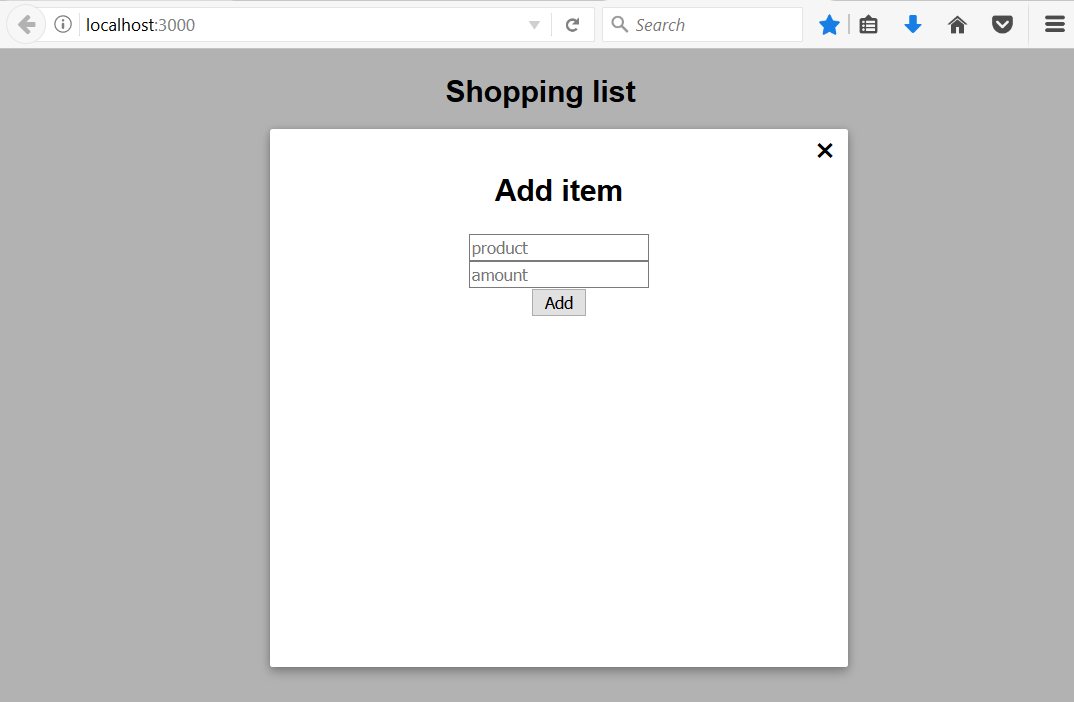
在输入框中输入一些值,然后按 添加 按钮。模态窗体关闭,可以在列表中看到新项目:

Material UI 是 实现 Google 的 Material Design 的 React 组件库。它包含许多不同的组件,例如按钮、列表、表格和卡片,您可以使用它们来获得漂亮且统一的用户界面。我们将继续使用购物清单应用程序,并开始使用 Material UI 设计用户界面:
- Open the shopping list app with VS Code. Install Material UI by typing the following command in the root folder to PowerShell or any suitable terminal you are using:
- We are ready to start to using the Material UI components. We will first change the buttons in the
AddItem.jsfile to use the Material UIButtoncomponent. We have to import theButtoncomponent and then use it in therender()method. Different props ofButtoncan be found in the Material UI documentation:
现在应用程序正在使用 RaisedButton,它看起来像这样:
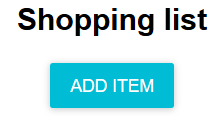
更改后,您的表单应如下所示:
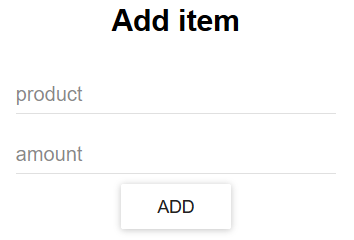
- Change our list in the
App.jsfile to use the Material UIListandListItemcomponents. Import the components and useListItemin the map function wherelistItemsare created and renderListinstead oful. We will show the amount of the product in the secondary text of theListItemTextcomponent:
现在用户界面看起来类似于 如下。通过少量的工作,用户界面现在更加精致:
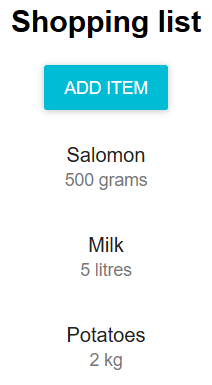
在 React 中有多种解决方案可用于 routing。我们使用的最流行的是 React Router (https://github. com/ReactTraining/react-router)。对于 Web 应用程序,React Router 提供了 一个名为 react-router-dom。
要开始使用 React Router,我们必须使用以下命令安装它:
react-router-dom 中有四个不同的组件需要实现路由。 BrowserRouter 是基于 Web 的应用程序的路由器。 Route 如果给定的位置匹配,组件会渲染定义的组件。以下是 Route 组件的两个示例。当用户导航到 /contact 结束路径时,第一个渲染 Contact 组件。您还可以将内联渲染与 Route 组件一起使用,如第二个示例所示:
Switch 组件包装了多个 Route 组件。 Link 组件为您的应用程序提供导航。以下示例显示 Contact 链接并导航到 /contact端点点击链接:
以下示例展示了如何在实践中使用这些组件。让我们使用 create-react-app 创建一个新的 React 应用程序,名为 routerapp。使用 VS Code 打开 app 文件夹并打开 App.js 文件到编辑器视图。从 react-router-dom 包中导入组件,并从渲染方法中移除额外代码。修改后,您的 App.js 源代码应如下所示:
让我们首先创建两个可以在路由中使用的简单组件。创建两个新文件, Home.js 和 Contact.js, 到应用程序根目录文件夹。仅向render() 方法添加标题以显示组件的名称。看组件的代码如下:
打开 App.js 文件,让我们添加一个 允许的路由器我们在组件之间导航:
现在,当您启动应用程序时,您将看到链接和 Home 组件,它显示在根结束路径 (localhost: 3030/) 在第一个 Route 组件中定义。第一个 Route 组件中的 exact 关键字表示路径必须完全匹配。如果你删除它,那么路由总是会转到 Home 组件:
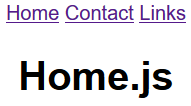
当您按下 Contact 链接时,Contact 组件被渲染:
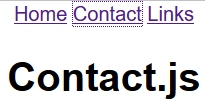
Packt 还有其他学习 React 的好资源:
